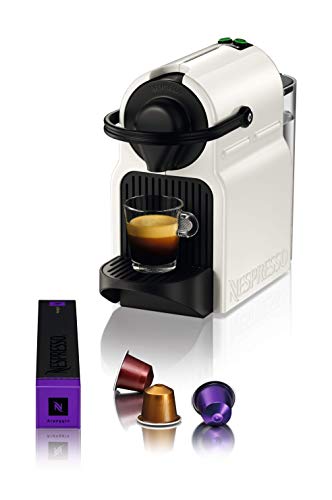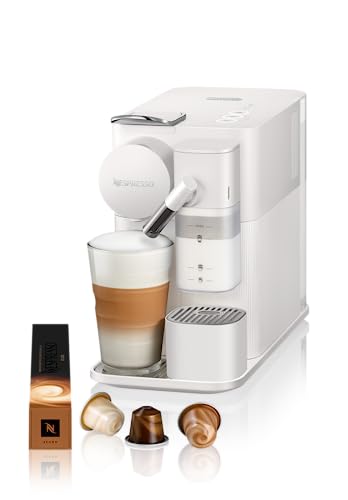![]()
Nespresso Coffee – The Essenza Mini
 The Essenza Mini is compact and affordable. It’s also very easy to use. It doesn’t have an adjustable drip tray or water tank to keep it small. However, it produces excellent espresso and lungo.
The Essenza Mini is compact and affordable. It’s also very easy to use. It doesn’t have an adjustable drip tray or water tank to keep it small. However, it produces excellent espresso and lungo.
It works by piercing the capsules and then pumping water under pressure. This creates different sizes of espresso as well as coffee drinks, including 1.35-ounce espressos, 2.7-ounces double espressos, 5-ounces gran lungos, or 14-ounces altos. It can be used with an independent milk frother.
Capsules
The Nespresso system lets you brew coffee at the touch of the button. You can select a single-serving cup or a larger size, and each capsule contains the right amount of beans for your desired strength. You can also add some milk powder to make cappuccino, macchiato latte or other drinks. The capsules can be recycled or disposed of with no guilt because they are made from biodegradable materials.
The pods are made of aluminum and are able to stand up to the pressure of the machine. The pods are sealed with a hermetically sealed seal, and the coffee grounds inside are fresh and protected from oxygen and moisture. Nestle’s environmental goals are in line with the fact that aluminium is recyclable 100% of the time.
The system comes with its own drawbacks. For one, the machines are expensive to purchase and operate. The capsules are also costly to purchase and need to be replaced regularly. Additionally, the machines can only be used with nespresso coffee machines best price-branded capsules. This has led to numerous lawsuits between Nestle, and third-party companies that use the same extraction methods and ingredients as Nespresso.
Despite these disadvantages, the Nespresso coffeee Machine system offers many advantages, including high-quality coffee and sustainability for the environment. It’s an excellent alternative to regular coffee and tea, and also has an extraction rate that is higher than the majority of single-serve systems. In fact, a single capsule can make up to 14 ounces of espresso-style coffee.
The first capsule design was developed in 1976, and it was first patented in 1979. Its main features include an aluminum foil cone container with a flat-topped top, an elongated recess that the machine injects hot water and a narrow opening in the base that is punctured from above and below. The capsule spins at 7000 rpm by the machine to infuse water into the coffee and create a thick creamy crema.
Water
It is crucial to use high-quality water when making use of a Nespresso. This ensures consistent quality and is important for the flavor and texture. You should make sure to use “filtered” water or “spring water,” and avoid tap water or distilled water.
In our laboratory tests, we’ve discovered that nespresso coffee machine sales machines with high-quality softened water produce more satisfying espressos and lungos than machines that use hard water. Hard water can lead to calcium deposits, as well as other problems which will affect the taste of your coffee.
In each cup during each cup, the Nespresso coffee machine releases hot water under high pressure. This process is known as extraction. The duration, temperature, and pressure of the extraction process are what determines the taste and intensity of your coffee.
The original machines cut the capsule and then pump it, while the Vertuo model reads the barcodes to determine the amount of water needed for each type of espresso. The Vertuo models can make six different drink sizes, including espressos and lungos with or without caps of foam.
All machines included in the Nespresso line produce 19 bars. Some of the more expensive machines also brew latte macchiatos and cappuccinos. Some machines also allow you to make an iced coffee.
The Inissia and U series machines come with compact bodies, which makes them easy to fit into tight spaces. The Nespresso Pixie, which has an integrated frother, is another compact option. It can also be paired with the nespresso machine with milk frother app to access custom recipes and reorder capsules. Nespresso is a good option for anyone looking to reduce their footprint on the environment and also support the company’s sustainability initiative.
Temperature
While Nespresso machines are more complicated than your average coffee maker, they’re built for speed and user-friendliness. Each capsule is made in a matter of seconds. They’re also fairly efficient. Contrary to traditional drip coffee makers which consume more electricity per cup of coffee, Nespresso machines only use a small amount of power to brew each capsule.
Some models of Nespresso coffee machines have a milk frother, which can be used for cappuccinos and lattes. Certain models have a separate capsule container that can hold up to 12 used capsules at one time making them easy to recycle.
The Nespresso brand is supported by a number of well-known kitchen equipment manufacturers such as Krups, DeLonghi and Breville. The majority of machines are made by Eugster/Frismag – an Swiss company that is among the world’s largest coffee-machine manufacturers. This has led to criticism of the company’s usage of patents and other similar strategies that printer manufacturers to create vendor lock-in.
Pressure
In order to get the best espresso possible, you need to maintain a consistent pressure throughout the extraction process. This is called “pressure profiling” and involves changing the pressure applied to the grounds to increase flavor and get optimal extraction. This technique can be achieved through the use of different espresso machines, including Nespresso coffee makers.
There are a variety of ways espresso machines can control the pressure during the extraction. A balanced bypass regulates the water pressure at a fixed amount, typically 9 bar, regardless of the inlet. This is a simple, effective method that ensures that all espresso groups are at the same pressure during the extraction process.
Another method is to manually adjust the pressure using the lever or control knob. This is a more complicated method, but it can provide a greater degree of customization and control. It is important to keep in mind that manual pressure regulation may result in inconsistent results, which is why it requires a high level of skill and attention.
Some espresso machines use dynamic pumps to adjust the pressure based on the temperature of the coffee grounds and the type of coffee being used. This type of system is more sophisticated, but can produce better results than other types.
Nespresso offers a range of machines that can make lungo and espresso drinks and others that can also frother milk. The Nespresso Inissia is a fantastic option for home baristas because it can make seven to nine espressos at a time and has a 33-ounce tank for water. It also has buttons for different sizes of drinks as well as a capsule tray that holds up to nine pods that have been used. The Nespresso Vertuo Next is designed to be versatile and comes with eleven milk temperatures as well as eight milk textures to select from. It also has a large stainless steel milk frother wand, as well as containers that can hold up to 18 ounces of used capsules.
Cleaning
If you use a nespresso capsule machine machine it will leave small limescale and mineral residues every time you make a cup. They can be mixed with your coffee, causing it to taste off. To avoid this from happening, it is essential to clean regularly your Nespresso machine and its components. The removable parts like the drip tray capsule container, washer and drip tray should be cleaned and descalked during a deep clean. A daily wash of the capsule container using fresh water will also help to prevent mineral buildup.
Utilizing a de-scaling product can help remove mineral deposits from your machine. You can find these products in a variety of coffee and appliance stores. You can also use vinegar. This abrasive cleaner won’t cause damage to your machine nespresso, however it may take a little longer to dissolve the minerals than a descaling liquid.
If you choose to use vinegar, first remove the coffee pods and empty the reservoir of water. Then, pour out the remaining water in the tank, including any filters. Pour in the vinegar and run a brew process without coffee pods so that it can flow through the machine. Then, wash with clean water and run a few more cycles to ensure there are no traces of vinegar left in the machine.
 Once you have your machine cleaned then you can clean the exterior as well as its removable parts. Pay particular attention to corners and crevices, where gunk can hide. You can either wash the parts that are removable with mild soap in your dishwasher or by hand. Rinse them thoroughly. Check the seals on the capsule as well as the coffee outlet and replace them if needed to maintain their elasticity.
Once you have your machine cleaned then you can clean the exterior as well as its removable parts. Pay particular attention to corners and crevices, where gunk can hide. You can either wash the parts that are removable with mild soap in your dishwasher or by hand. Rinse them thoroughly. Check the seals on the capsule as well as the coffee outlet and replace them if needed to maintain their elasticity.